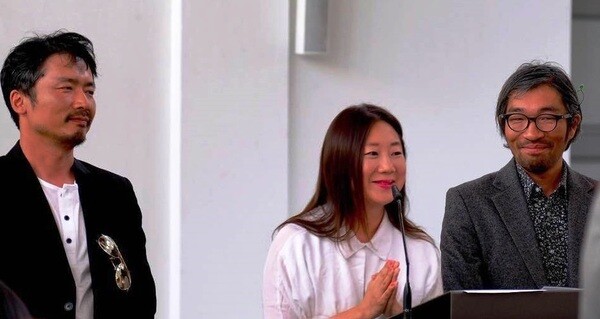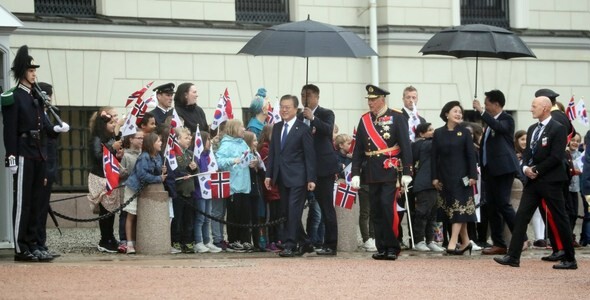hankyoreh
Links to other country sites 다른 나라 사이트 링크
[Interview] Planting South and North Korean flowers in downtown Berlin

“Our project changes in fluid ways with the state of inter-Korean relations. I thought that aspect itself could be an artistic process: the artwork takes on dynamic variables amid the dynamics of politics. Right now, we’re waiting for plants to arrive from North Korea.”
A 3D miniature version of the Baekdudaegan mountain range, reminiscent of the landscape painting “After Rain at Mt. Inwang” by artist Jeong Seon (1676–1759, known by the pen name “Gyeomjae”), has been created in Berlin. Part of the “Third Nature” project, the creation has clouds and mist billowing over a mountain of rocks modeled on the Baekdudaegan range in basalt and earth. In the garden, indigenous South and North Korean flora has been planted from across the Korean Peninsula.
The opening ceremony on the evening of May 23 attracted major attention, with around 600 exchange students, overseas Koreans, and local residents joining installation artists Han Seok-hyeon, 44, and Kim Seung-hee, 41. Planning and organization were supervised by Kim Keum-hwa, 41, curator of Keum Art Projects.
“Pretty soon, the whole thing will be covered in white flowers,” the artists explained on June 8 at the garden, which was created on a site in Berlin’s Kulturforum and Matthaeuskirche.
After conceiving of the project three year ago, Kim Keum-hwa’s first stop was the North Korean Embassy in Berlin.
“The response from the North was positive. We arranged to receive North Korean flora through the inter-Korean joint liaison office at the Kaesong Industrial Complex,” she explained.
“But when they second North Korea-US summit in Hanoi collapsed last February, we were at a loss. We’re still in contact, but we haven’t received a response.”
Kim added, “While doing this project, I gained a new sense of what it means to be citizens of a divided country.”
“I’d like for there to be progress soon in inter-Korean exchange so that we can have South and North Korean ecologists holding a symposium in this garden to discuss the plants of the Baekdudaegan,” she said.
The garden’s setting is surrounded by the Matthaeuskirche (which also serves as a cultural foundation), the Kulturforum’s collection of national art museums, and the Berlin Philharmonic.
“This is a cultural center in western Berlin, and it’s close to where the Wall used to be. It was put together by West Germany during the days of division into East and West in order to prove the superiority of its political system. It still draws around 100,000 tourists each year.”
It wasn’t easy crafting a garden in this illustrious center of Berlin. The most difficult issue concerned permits. The artists were unable to do everything they had hoped; they had to comply with German standards in the specifications and construction methods and follow the legally stipulated procedures. Once the permit was in hand, Kim Seung-hee was responsible for selecting and transporting the plants. In January, he began bringing them in and transplanting them by way of the Berlin Botanical Garden.
Selecting 23 North Korean plants and 37 South Korean ones, he was able to transport 45 seedlings to Berlin. The group also had to cooperate closely with South Korean and German agencies. The Berlin Botanical Garden, the St. Matthew Foundation, and the local parks and art agencies provided major assistance, as the landscaping and installation required the technology and consulting of German experts.
“We’re also proud of it being a project achieved together with German agencies,” Kim Keum-hwa said.

Budget issues were another obstacle. In March, the group launched a month-long crowdfunding effort. Awareness of the project increased, and 32,500 euros (US$36,847) were raised. Messages of support were sent by figures from all walks of life, including actors Kim Sung-ryung, Kim Ah-joong, and Han Ji-min; hip hop act Epik High; and star lecturer Kim Chang-ok.
For the artwork, Han was responsible for the overall visuals, while Kim Seung-hee handled the plant-related aspects. Han studied art at Hongik University and the Korea National University of Arts (K-Arts). Kim studied fine arts at K-Arts before receiving a master’s in landscaping from the University of Seoul. While Han’s artistic efforts have concerned using the distorted image of nature within the processes of industrialization and urbanization as a means of exploring the essence of nature, Kim’s work has been related to indigenous regional cultures in the area of public art, which combines fine arts with landscaping.
The key theme of the Third Nature project was the idea that “nature has no boundaries.” Kim Keum-hwa explained, “The garden itself already symbolizes a utopia. It’s nature as created by human beings, and within it we create the ideal space that human beings dream of.”
“The garden that the artists had in mind was Mt. Inwang after the rain, as painted by Jeong Seon. It’s an image of Mt. Inwang in Seoul, cloaked in clouds after the rain has just ended,” she added.
“We saw it as an image that symbolizes a state that is uncertain politically, but where we still harbor hope. Doesn’t it seem like the ink-and-wash technique has been used to show some abstract state between hope and uncertainty?”
Han first had the idea of an artistic garden when he arrived for a residency at Berlin’s Arthouse Bethanien in 2016.
“When I first arrived in Berlin in the spring three years ago, everyone looked so peaceful and happy and content. It was a very different feeling from Korea,” he said.
Germany’s reunification as inspiration for Korea’s
“I had the thought that it was the reunification of East and West Germany that had brought about this sense of stability and peace. As I thought about it more, I realized that while I had often talked about reunification with my friends up until college, I hadn’t spoken to anyone in the past 10 years about any kind of promising future or unification. As an artist, I wanted to do something related to South and North Korea. I saw a documentary that showed the moment the Berlin Wall came down, and it moved me to tears. Just as the German reunification happened because there were more people who wanted it, who came and went freely and kept demonstrating, I thought South and North Koreans need to meet and talk more often rather than waiting for some political decision to be made.”
“I hope that people from South and North Korea will come together in this garden to talk about things. I think that with a glass of makgeolli [rice wine], they might be happy,” he added.
“I want inter-Korean relations to thaw before the flowers all fall.”
The Third Nature project will be continuing until Nov. 15. Other plans for the project include performances by Korean artists living in Berlin, recitals and debates, a concert by singer and support association member Lang Lee, and a temple food tasting by Buddhist monk Jeonggwan.
By Han Joo-yeon, correspondent in Berlin
Please direct comments or questions to [english@hani.co.kr]

Editorial・opinion
![[Column] Has Korea, too, crossed the Rubicon on China? [Column] Has Korea, too, crossed the Rubicon on China?](https://flexible.img.hani.co.kr/flexible/normal/500/300/imgdb/original/2024/0419/9317135153409185.jpg) [Column] Has Korea, too, crossed the Rubicon on China?
[Column] Has Korea, too, crossed the Rubicon on China?![[Correspondent’s column] In Japan’s alliance with US, echoes of its past alliances with UK [Correspondent’s column] In Japan’s alliance with US, echoes of its past alliances with UK](https://flexible.img.hani.co.kr/flexible/normal/500/300/imgdb/original/2024/0419/2317135166563519.jpg) [Correspondent’s column] In Japan’s alliance with US, echoes of its past alliances with UK
[Correspondent’s column] In Japan’s alliance with US, echoes of its past alliances with UK- [Editorial] Does Yoon think the Korean public is wrong?
- [Editorial] As it bolsters its alliance with US, Japan must be accountable for past
- [Guest essay] Amending the Constitution is Yoon’s key to leaving office in public’s good graces
- [Editorial] 10 years on, lessons of Sewol tragedy must never be forgotten
- [Column] A death blow to Korea’s prosecutor politics
- [Correspondent’s column] The US and the end of Japanese pacifism
- [Guest essay] How Korea turned its trainee doctors into monsters
- [Guest essay] As someone who helped forge Seoul-Moscow ties, their status today troubles me
Most viewed articles
- 1[Column] The clock is ticking for Korea’s first lady
- 2After 2 months of delayed, denied medical care, Koreans worry worst may be yet to come
- 3[Column] Has Korea, too, crossed the Rubicon on China?
- 4Hong Se-hwa, voice for tolerance whose memoir of exile touched a chord, dies at 76
- 5US overtakes China as Korea’s top export market, prompting trade sanction jitters
- 6[Correspondent’s column] In Japan’s alliance with US, echoes of its past alliances with UK
- 7All eyes on Xiaomi after it pulls off EV that Apple couldn’t
- 8[News analysis] After elections, prosecutorial reform will likely make legislative agenda
- 9Samsung barricades office as unionized workers strike for better conditions
- 10More South Koreans, particularly the young, are leaving their religions